Odds & Ends: Guilds of Ravnica
Every set, I have a mailbag column where I answer all of your questions about the latest set. Today, I'm going to answer questions about Guilds of Ravnica.
Here's the tweet I posted:
I'm doing a mailbag column on #mtggrh. Send me single tweet questions you have about Guilds of Ravnica. Thanks. #WotCStaff
— Mark Rosewater (@maro254) October 5, 2018
As always, I'll try to answer as many questions as I can, but here's why I might not answer your question:
- I have an allotted word count, which means that there are only so many questions I can get to.
- Someone else might have asked the same question. I will usually answer the first person who asks.
- Some questions I either don't know the answer to or don't feel qualified enough in the area to properly answer.
- Some topics I'm not allowed to discuss for all sorts of reasons, including previews for future sets.
With that out of the way, let's get to the questions.
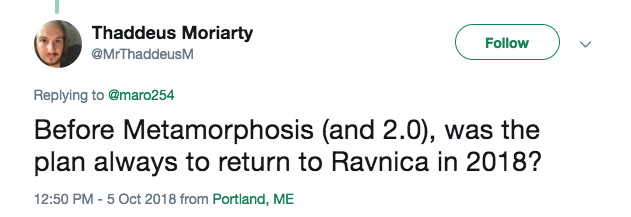
The third trip to Ravnica was basically planned as soon as Return of Ravnica block came out to a huge positive fan reaction. Our job is to put out sets you all want to play. Ravnica is a fan favorite and is, statistically speaking, the most popular world we've ever made. The mix of guilds, multicolor cards and hybrid mana, the city tropes and the characters, and all the rest combine to make something players are happy with every time we visit it.
We then incorporated it into our larger Bolas storyline, and it became very entrenched into our schedule. We did talk when Metamorphosis 1.0 sped up the rate we were releasing worlds, but decided it showing up a smidgeon earlier wasn't going to be a problem. By the time Metamorphosis 2.0 happened, it was already being worked on, so there was no changing it at that point.
If or when we make a fourth visit will be heavily influenced by what happens to Ravnica in the coming year.

We're conscious when we make any design what impact it will have on our digital products (Magic: The Gathering Arena and Magic: The Gathering Online). Nothing is strictly off limits, but certain choices come with ramifications that we take seriously. I'll put these concerns into three categories. Category One is what I'll call "The Little Stuff." For example, we think about how many clicks a card will take when used. If we can have a similar effect with fewer clicks, we'll often consider changing the card to that. We also think about the opportunities for misclicks and decide how often we expect a card to be used in another fashion. If we feel its alternate-use case is small enough and the misclicks we'll be damaging enough, we'll consider restricting what the card can affect.
Category Two is what I'll call "The Big Stuff," when we introduce something brand new, something the rules engine hasn't handled before, or something that requires substantial new programming to function. In those cases, we sit down with the digital teams and talk through how important the element is to the design and how big the cost of implementation is (in terms of people, time, and other resources). If the element is instrumental to the design, we'll figure out how to make it happen. In contrast, if a single card or cycle that's not instrumental to the set would require a huge amount of resources, we'll consider changing that card to something else.
Category Three is what I'll call "Best-of-One Issues," and it applies mainly to Magic: The Gathering Arena. The vast majority of MTG Arena games are single games, which means there's no sideboarding. A lot of the way Magic has treated metagame answers in the past is making cards that can be sided in if a problem occurs. Single-game matches are making us question how we address answer cards. This is definitely making us rethink a number of ways in how we design.
Guilds of Ravnica definitely had a bunch of cards in Category One, things that were tweaked to make a better digital experience while having minimal effect on the tabletop game. It had no Category Two issues. Guilds of Ravnica didn't do anything that deviated greatly from things we've executed on before digitally. Category Three was just starting to become a thing when we were making Guilds of Ravnica, so while it may have had some smaller impacts, it didn't have a larger one.
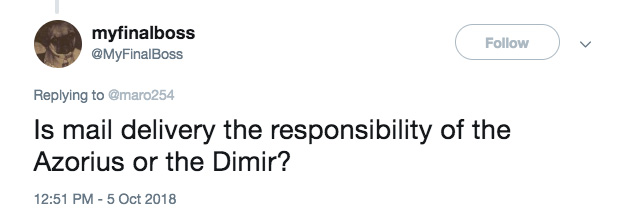
My best guess is that the normal mail is handled by the Azorius, but if you have a special delivery that you don't want anyone knowing about, Dimir's your guild.
Letter in your mailbox? Azorius.
Package mysteriously shows up in your house? Dimir.
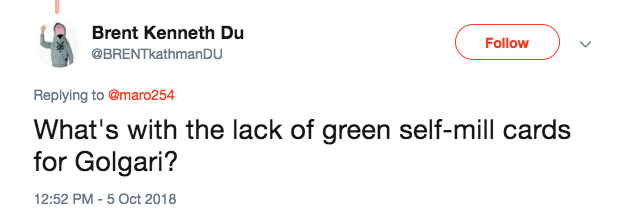
Set Design had two choices. They could put in green self-milling (something green doesn't do often, but we tend to put into graveyard-focused sets) and then cost the undergrowth cards around those cards, or they could let players get their creatures to the graveyard through combat, sacrifice, and discard, and cost accordingly. The former ended up making the Golgari strategy only work efficiently if you got access to the self-milling cards, as the undergrowth cards were costed assuming you had. The latter allowed Play Design to be more aggressive when costing undergrowth and made for better gameplay. It also meant that surveil was able to play a more integral role in the Golgari decks and helped encourage the splashing of blue.
It's important to note that one of the ways of balancing themes in a set is being careful about how many and what enablers you put into the various colors. Just because an enabler can work in a set doesn't mean it should always be included.
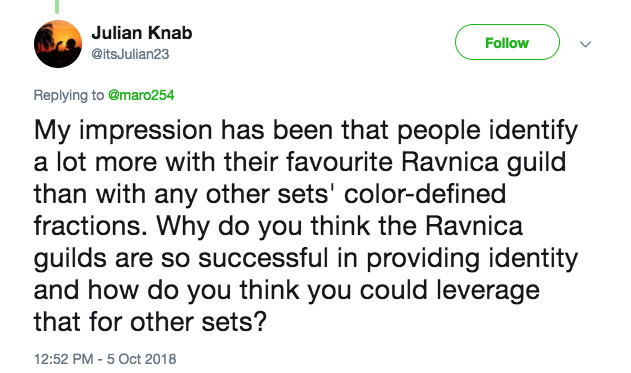
Players have always related to color more so than any other component in Magic. My best guess is because color means something on a deeper level. Colors represent philosophies, ideals, ways of looking at life. They speak on a subconscious level that rings true. Ravnica: City of Guilds was the first time we took color combinations and gave them faction identities. Two colors seem to be the right mix where there's enough differentiation to be distinct but not too much that it muddies what the faction stands for.
Also, because it was the first time we'd made factions based on multicolor combinations, we tended to pick the lowest hanging fruit. Yes, any one two-color combination could represent a bunch of different things, but we chose the most obvious representation. The guilds also had the advantage of being part of Ravnica, which was designed to play up the factions' identities.
We definitely recognize the popularity of the guilds and have spent a lot of time trying to use that understanding to make new factions (and not just with color). It's been tough though. For example, here's some different things we've experimented with:
- Other color combinations – Monocolor already has an identity, so it's tricky to make a faction identity that stands on its own. Three-color is just a little broader and harder to pin down what exactly it stands for. Three-color design, for example, always has players questioning why something couldn't just be two colors. (Note three-color factions are popular, and I expect we'll revisit them.) Four-color is very hard to design cards for. Five-color is a faction of one.
- Creature types – Creature types come with a lot of flavor and are easier to build around (especially the more resonant ones), but there's less psychological connection.
- Card types – This is something we can mechanically build around, but they feel more esoteric and less something players can psychologically bond with.
Factions have proven a potent design component (especially color-based factions), so we're still trying to figure out how best to use them. As you'll see in the upcoming years, we're trying some interesting new things as well as reinterpreting combinations you've seen in the past.
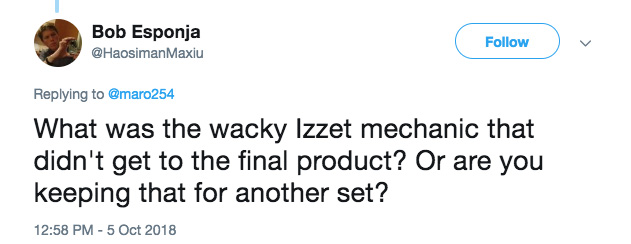
The Izzet mechanic we handed off from Vision Design to Set Design was called "jewel." It went on any instant or sorcery. After the card resolved, it got exiled. Then, whenever you cast another instant or sorcery, you could play the first card for free from exile. The idea behind it was that we built smaller effects that comboed together to do cool things. We wanted the mechanic to capture the sense of creativity that is such a strong part of the Izzet philosophically but has never really shown up on its mechanics.
Set Design found the free second cast a problem, so they changed it to have a cost and to be playable on any turn that an instant or sorcery was played, allowing you to double-cast any of them on the same turn. That execution didn't quite work, but it was the inspiration for jump-start as Set Design wanted to find a different way to let you cast the spells a second time, so you could mix and match them. The discard was added to avoid the card advantage that was making it too powerful, and it was moved from exile to the graveyard as that allowed other guilds to better interact with it.
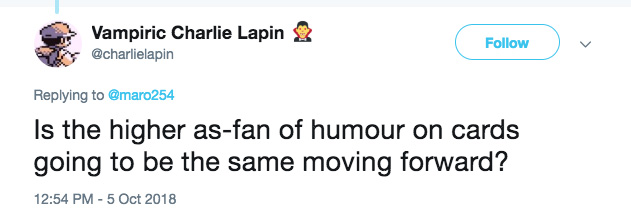
I believe the creative team is experimenting with how much humor to have in the game, through names, flavor text and card concepting. The general consensus is Magic can be a bit higher than it has been, but I'm not sure what exactly the right level is going to end up at. Ravnica is definitely a world that's ripe for humor, so don't necessarily expect that every future world will be at this level.
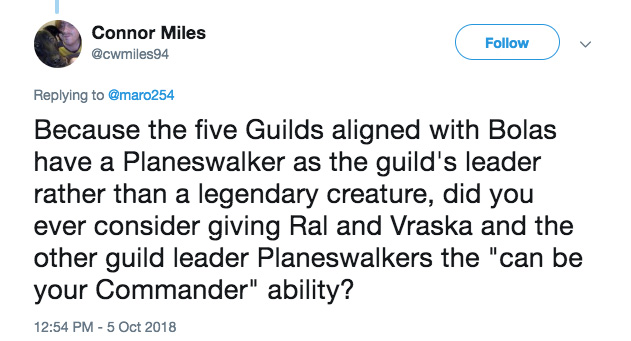
That was never considered because one of our rules is that in Standard-legal sets, we don't reference components that won't work within Standard. We've learned through the years that players are bad at ignoring components on a card, so we try not to include rules text that players are supposed to ignore. That doesn't mean we can't have things that don't work better in a certain format. They just have to work in Standard. This allows us to make cards that play better in multiplayer, for instance, yet still include them in booster packs. Things specifically for other formats (using rules text that doesn't make sense in Standard) are reserved for supplemental products dedicated to that format. For example, if we want to reference something being able to be a commander, we put that in a Commander product.
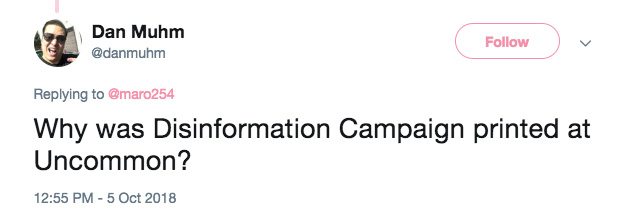
Because it's an effect that can be done at uncommon. Uncommon can have both repeatable draw and repeatable discard. Also, by making it uncommon, it becomes a draft-around card that can encourage players to draft a surveil deck.
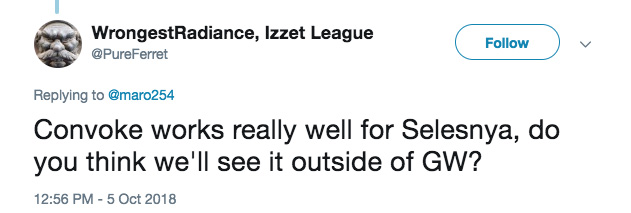
We've already seen it outside of green and white. Convoke was in Magic 2015 and showed up in all five colors. Will we see it in the future in other colors? Most likely. The mechanic is popular and has a deep design space, making it likely to return outside of Ravnica.
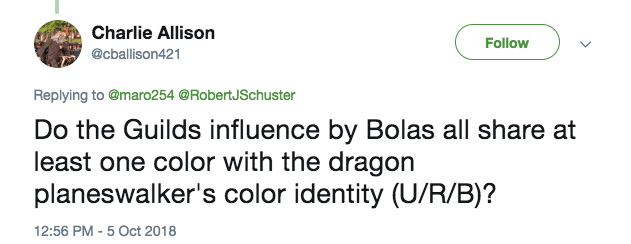
Nicol Bolas's color identity is blue-black-red, and we already know that Selsenya is not one of the guilds under his thumb (possibly metaphorically as I'm not sure if Dragons have thumbs). This means that, by definition, every guild under his influence will have at least one color in common as the other nine guilds all do.
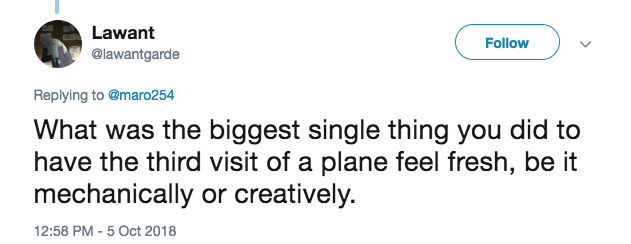
The biggest difference has to be the tone. Making this part of the larger story adds Bolas to the mix, and his influence is felt throughout all ten guilds as each struggles with whether they're going to ally with him. Although five fall under his influence, the other five still struggle internally with pro-Bolas elements. This tone was matched in the art direction—it's fall and rainy and dark, and the overall mood is one of suspicion and distrust. The mechanics definitely try to match that tone, but the flavor carries the burden of it.
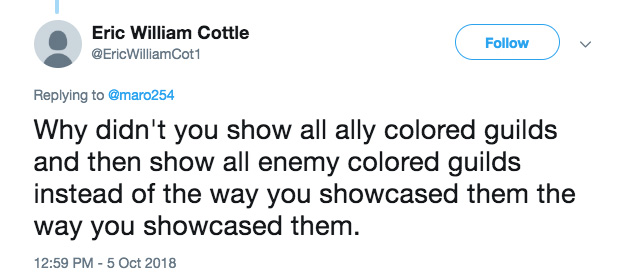
Magic just turned 25 years old. Every year, we put out four Standard-legal sets and numerous supplemental products. It's very important that we make sets feel different from one another. This means whenever possible, we lean into doing things that can only be done in the set you're making. Ally-color sets and enemy-color sets are something we can do outside of Ravnica (see Invasion, Planeshift, Apocalypse, Shadowmoor, Eventide, Dragons of Tarkir, and Unstable). A set that mixes and matches various two-color combinations is much harder to do, so we purposefully avoid dividing Ravnica sets by ally and enemy, and allow other divisions the chance to get their time in the sun.

It wasn't anything nefarious, and Weirds still exist on Ravnica. It was just a case of the numbers not working out. Izzet, being the two spell colors, had the fewest number of creatures to begin with, and there just wasn't a creature that seemed like a perfect fit for a Weird at the time. (Yes, with 20/20 hindsight, maybe Runaway Steam-Kin could have been a Weird.)
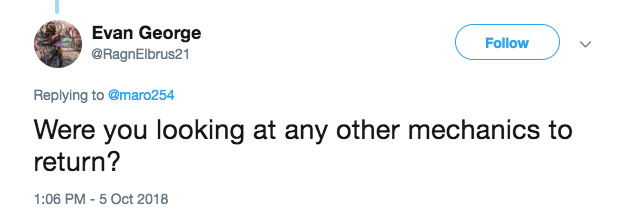
We looked at splice for Izzet (using splice onto instants and sorceries instead of splice onto arcane). We considered unearth for Golgari. We talked about battlecry for Boros. We handed over a tweaked ninjutsu for Dimir. Ironically, Selesnya was the one guild we didn't think about a repeat mechanic for in Vision Design.
Tweeting Halfway
That's all the time I've got for today. As always, I'm eager to hear your thoughts on today's column, any of my answers, or on Guilds of Ravnica itself. You can email me or contact me through any of my social media accounts (Twitter, Tumblr, Google+, and Instagram).
Join me next week as I answer more of your Guilds of Ravnica questions.
Until then, may my answers help you enjoy Guilds of Ravnica even more.
#583: Lessons Learned – Ixalan
#583: Lessons Learned – Ixalan
37:35
This is another in my series "Lessons Learned," where I examine sets I led or co-led and talk about what I learned from doing the design. In this podcast, I talk about the design of Ixalan.
#584: Alpha Playtesters
#584: Alpha Playtesters
34:43
Inspired by a video about the people who playtested Magic before it came out, I go into greater detail about the various playtesters.
- Episode 582 Creature Types
- Episode 581 Narrative Equity
- Episode 580 Busy R&D

